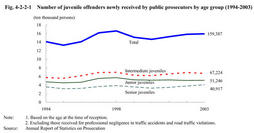| Previous Next Index Image Index Year Selection | |
|
|
1. Prosecution of juvenile cases Fig. 4-2-2-1 shows the number of juvenile offenders aged14-19newly received by public prosecutors(excluding those for professional negligence in traffic accidents and road traffic violations)in the last10years and a breakdown by age group.The total number peaked in1998at165,952and then temporarily decreased before starting to increase again from2001.Breaking it down by age group,junior juveniles have leveled off since1999,while senior juveniles have been on the rise since2001.In2003,junior and senior juveniles increased by0.6%and7.3%respectively in number,whereas intermediate juveniles decreased by2.9%from the previous year.
Fig. 4-2-2-1Number of juvenile offenders newly received by public prosecutors by age group(1994-2003) Fig. 4-2-2-2 shows the percent distribution of juvenile offenders aged14-19newly received by public prosecutors for major offenses in2003by type of offense and age group(see Appendix4-7).Regarding homicide and robbery,senior and intermediate juveniles had large shares.With regard to extortion and theft,intermediate juveniles constituted the largest group.As for rape/indecent assault,professional negligence in traffic accidents,road traffic violations,and Stimulant Drug Control Law violations,senior accounted for the largest share.In2003,the total number of juveniles referred for homicide increased by14.1%,while robbery also rose by10.3%,rape/indecent assault by16.9%,and arson by21.9%from the previous year.Breaking it down by age group,the percentage of junior juveniles referred for homicide increased by9.4points compared to the previous year(an increase of11juveniles).A public prosecutor attaches his or her opinion about the treatment of the juvenile when the public prosecutor refers a juvenile case to a family court.Appendix4-8shows the percent distribution of opinions attached by public prosecutors regarding appropriate measures such as criminal disposition,commitment to a juvenile training school,or probation that should be taken for juveniles finally disposed by family courts in2003for penal code offenses or special law offenses(excluding professional negligence in traffic accidents and road traffic violations). Fig. 4-2-2-2Percent distribution of juvenile offenders aged14-19newly received by public prosecutors for major offenses by type of offense and age group(2003) Table 4-2-2-3 shows the disposition by public prosecutors for those juveniles that were transferred to public prosecutors by family courts in2003.The percentage of those who were brought to formal trial to the total prosecuted juveniles(6,695)in2003was6.3%(56.3%for penal code offenses,and1.2%for special law offenses),down0.7points as a whole(3.7points for penal code offenses,and0.7points for special law offenses)from the previous year.Table 4-2-2-3Number of juveniles referred to and disposed by public prosecutors by type of offense(2003) |


